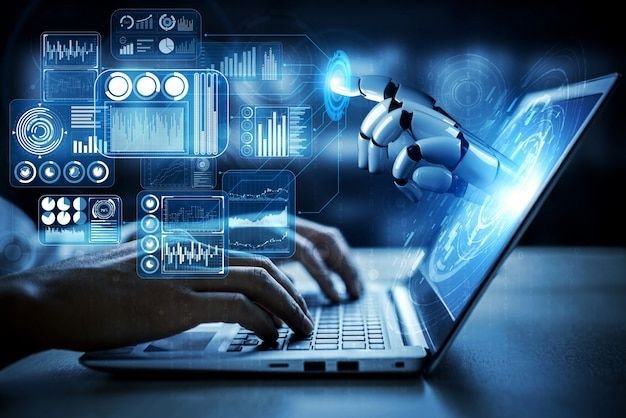
Robotics has come a long way from its early roots in industrial automation. Today, robots are not only performing repetitive tasks in factories but are also playing a crucial role in enhancing human capabilities across various fields. From healthcare and education to manufacturing and everyday life, robotics is augmenting human abilities, enabling people to perform tasks that were once impossible or extremely difficult. This article explores the role of robotics in enhancing human capabilities, the key areas where this technology is making a significant impact, the challenges involved, and what the future holds.
How Robotics Enhances Human Capabilities
Robotics enhances human capabilities by augmenting physical, cognitive, and sensory abilities. By working alongside humans or autonomously, robots can extend the range, precision, and efficiency of human actions. This enhancement comes in various forms:
Physical Augmentation
Robotics can enhance human physical capabilities by providing strength, endurance, and precision beyond natural human limits. Examples include:
– Exoskeletons: Wearable robotic exoskeletons are designed to assist individuals with mobility impairments or to enhance the physical abilities of workers in physically demanding jobs. These devices provide support and additional strength, allowing users to lift heavier objects, walk longer distances, and reduce the risk of injury.
– Surgical Robots: In healthcare, surgical robots allow doctors to perform complex procedures with greater precision and control. These robots enhance a surgeon’s capabilities by providing steady, precise movements, often resulting in less invasive surgeries, reduced recovery times, and improved patient outcomes.
Cognitive Augmentation
Robotics also plays a significant role in augmenting human cognitive capabilities by assisting with complex decision-making, data analysis, and problem-solving. Examples include:
– Artificial Intelligence (AI) in Robotics: Robots equipped with AI can process vast amounts of data, recognize patterns, and make decisions based on that information. This capability is particularly valuable in fields like healthcare, where robots can assist in diagnosing diseases, suggesting treatment plans, or monitoring patient health.
– Educational Robots: In education, robots can be used to enhance learning experiences by providing personalized instruction, adapting to individual student needs, and offering interactive lessons that engage students more effectively than traditional methods.
Sensory Augmentation
Robotics can enhance human sensory capabilities by providing access to information that would otherwise be beyond human perception. Examples include:
– Robotic Prosthetics: Advanced prosthetic limbs equipped with sensors can restore a sense of touch to amputees. These prosthetics use robotics to mimic natural limb movements and provide sensory feedback, allowing users to interact with their environment in ways that were previously impossible.
– Environmental Monitoring Robots: Robots equipped with sensors can detect changes in the environment, such as temperature, radiation, or pollution levels, providing valuable data that can inform human decisions. These robots enhance our ability to monitor and respond to environmental changes in real-time.
Key Areas Where Robotics is Enhancing Human Capabilities
Healthcare and Medicine
Healthcare is one of the most significant areas where robotics is enhancing human capabilities. From surgical robots that allow for minimally invasive procedures to robotic prosthetics that restore mobility and function, robotics is transforming the field of medicine.
Assistive Robots
Assistive robots are designed to help individuals with disabilities or age-related challenges. These robots can perform tasks such as feeding, bathing, or mobility assistance, enabling individuals to live more independently. For example, robotic wheelchairs with advanced navigation systems allow users to move through complex environments with ease, significantly improving their quality of life.
Telemedicine Robots
Telemedicine robots are enabling healthcare providers to deliver care remotely, particularly in underserved or remote areas. These robots can be used for remote consultations, diagnostics, and even surgeries, allowing doctors to provide care to patients who might otherwise have limited access to medical services.
Manufacturing and Industry
In manufacturing and industry, robotics has long been used to automate repetitive tasks, but today, robots are enhancing human capabilities in more sophisticated ways.
Collaborative Robots (Cobots)
Collaborative robots, or cobots, are designed to work alongside human workers, enhancing their capabilities on the factory floor. Cobots can assist with tasks that require precision, strength, or repetitive motion, allowing human workers to focus on more complex or creative aspects of production. This collaboration increases productivity, reduces the risk of injury, and improves the overall quality of manufactured goods.
Robotic Exoskeletons
In industrial settings, robotic exoskeletons are being used to reduce the physical strain on workers. These wearable devices provide support and strength, allowing workers to lift heavy objects, maintain awkward postures, or work for extended periods without fatigue. By enhancing physical capabilities, exoskeletons help prevent injuries and extend the careers of workers in physically demanding jobs.
Education and Training
Robotics is playing an increasingly important role in education and training, enhancing the learning experience and providing new opportunities for skill development.
Educational Robots
Robots in the classroom can provide personalized learning experiences for students. For example, robots can be programmed to teach subjects like math, science, or language arts, adapting their instruction to the needs of individual students. This personalized approach can help students learn at their own pace and improve educational outcomes.
Simulation and Training Robots
In professional training, robots are used to simulate real-world scenarios, allowing individuals to practice and hone their skills in a controlled environment. For example, medical students can use robotic simulators to practice surgeries or other procedures before working on actual patients. Similarly, pilots can use flight simulators equipped with robotics to train for various flight conditions, enhancing their capabilities and confidence.
Daily Life and Personal Assistance
Robotics is also making its way into everyday life, enhancing human capabilities in routine tasks and personal assistance.
Home Robots
Home robots, such as robotic vacuum cleaners, lawnmowers, or personal assistants like robotic companions, are designed to assist with daily tasks. These robots enhance human capabilities by taking over mundane chores, freeing up time for individuals to focus on more meaningful activities.
Social Robots
Social robots are designed to interact with humans in a more personal and engaging way. These robots can provide companionship, emotional support, and even assist with mental health therapy. For example, robots designed for elderly care can engage in conversations, remind users to take their medication, or help them stay socially connected, enhancing their overall well-being.
Space Exploration and Research
Robotics is crucial in space exploration, where human capabilities are limited by the harsh conditions of space. Robots are enhancing our ability to explore and study distant planets, moons, and other celestial bodies.
Robotic Rovers
Robotic rovers, like those deployed on Mars, are equipped with advanced sensors and tools to explore the surface of planets. These robots can conduct experiments, collect samples, and send data back to Earth, enabling scientists to study environments that are too dangerous or distant for humans to reach.
Astronaut Assistance
In space missions, robots are also being developed to assist astronauts. These robots can perform maintenance tasks, conduct repairs, or even assist with complex scientific experiments, enhancing the capabilities of human astronauts and increasing the safety and success of space missions.
Challenges and Ethical Considerations
While robotics offers significant potential to enhance human capabilities, there are several challenges and ethical considerations that must be addressed.
Cost and Accessibility
The development and deployment of advanced robotics can be expensive, which may limit access to these technologies for individuals or organizations with limited resources. Ensuring that the benefits of robotics are accessible to all, regardless of economic status, is a significant challenge that must be addressed.
Job Displacement
As robots take over tasks traditionally performed by humans, there is a risk of job displacement in certain industries. While robotics can create new opportunities and roles, it is essential to manage the transition to ensure that workers are not left behind. This may involve retraining programs, education initiatives, and policies that support workers in adapting to new roles.
Privacy and Security
Robots, especially those equipped with AI and connected to the internet, can collect and process vast amounts of personal data. Ensuring that this data is handled securely and that privacy is protected is critical to maintaining public trust in robotics. Additionally, safeguarding robotic systems from hacking or malicious use is a growing concern that requires robust security measures.
Ethical Use of Robotics
The ethical use of robotics, particularly in areas like healthcare and warfare, raises important questions. For example, the use of autonomous robots in medical decision-making or combat scenarios requires careful consideration of the potential consequences and moral implications. Establishing ethical guidelines and oversight for the development and deployment of robotics is essential to ensure that these technologies are used responsibly.
The Future of Robotics in Enhancing Human Capabilities
The future of robotics in enhancing human capabilities is bright, with several emerging trends likely to shape the field in the coming years.
Integration with Artificial Intelligence
The integration of robotics with artificial intelligence will further enhance human capabilities by enabling robots to perform more complex and autonomous tasks. AI-powered robots will be able to learn from their experiences, adapt to new situations, and make decisions in real time, making them even more valuable partners in various fields.
Human-Robot Collaboration
As robotics technology advances, we can expect to see more sophisticated human-robot collaboration, where robots and humans work together seamlessly to achieve shared goals. This collaboration will enhance productivity, creativity, and innovation across industries, from healthcare to manufacturing to education.
Expansion of Wearable Robotics
Wearable robotics, such as exoskeletons and robotic prosthetics, will continue to evolve, becoming more lightweight, affordable, and integrated with the human body. These advancements will further enhance physical capabilities, allowing individuals to overcome disabilities, improve their performance, and extend their physical abilities beyond natural limits.
Robotics in Everyday Life
Robots will increasingly become part of our daily lives, assisting with routine tasks, providing companionship, and enhancing our quality of life. As robots become more intuitive and user-friendly, they will be integrated into homes, workplaces, and public spaces, making them an essential part of modern society.









